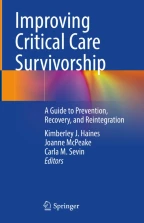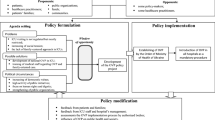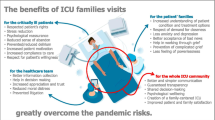Flexible ICU Visiting Policies

Most intensive care units (ICUs) worldwide adopt restrictive visiting policies. However, the evidence about the topic suggests that flexible visiting models are safe and associated with better outcomes among patients and family members. In this chapter, we will discuss the current practices regarding ICU visiting policies around the world and the effects of implementing a flexible visiting policy for family members in adult ICUs.
This is a preview of subscription content, log in via an institution to check access.
Access this chapter
Subscribe and save
Springer+ Basic
€32.70 /Month
- Get 10 units per month
- Download Article/Chapter or eBook
- 1 Unit = 1 Article or 1 Chapter
- Cancel anytime
Buy Now
Price includes VAT (France)
eBook EUR 85.59 Price includes VAT (France)
Softcover Book EUR 105.49 Price includes VAT (France)
Hardcover Book EUR 147.69 Price includes VAT (France)
Tax calculation will be finalised at checkout
Purchases are for personal use only
Similar content being viewed by others

Introduction of open visiting policy in intensive care units in Ukraine: policy analysis and the ethical perspective
Article 21 July 2018

Why and how to open intensive care units to family visits during the pandemic
Article Open access 02 June 2021
Reappraisal of visiting policies and procedures of patient’s family information in 188 French ICUs: a report of the Outcomerea Research Group
Article Open access 26 August 2016
References
- Vandijck DM, Labeau SO, Geerinckx CE, et al. An evaluation of family-centered care services and organization of visiting policies in Belgian intensive care units: a multicenter survey. Heart Lung. 2010;39(2):137–46. ArticleGoogle Scholar
- Ramos FJ, Fumis RR, de Azevedo LC, et al. Intensive care unit visitation policies in Brazil: a multicenter survey. Rev Bras Ter Intensiva. 2014;26:339–46. ArticleGoogle Scholar
- Garrouste-Orgeas M, Vinatier I, Tabah A, et al. Reappraisal of visiting policies and procedures of patient's family information in 188 French ICUs: a report of the Outcomerea Research Group. Ann Intensive Care. 2016;6:82. ArticleGoogle Scholar
- Giannnini A, Miccinesi G, Leoncino S. Visiting policies in Italian intensive care units: a nationwide survey. Intensive Care Med. 2008;17:1256–62. ArticleGoogle Scholar
- Haghbin S, Tayebi Z, Abbasian A, et al. Visiting hour policies in intensive care units, Southern Iran. Iran Red Crescent Med J. 2011;13:684–6. ArticleCASGoogle Scholar
- Noordermeer K, Rijpstra TA, Newhall D, et al. Visiting policies in the adult intensive care units in the Netherlands: survey among ICU directors. ISRN Critical Care 2013; article ID 137045. Google Scholar
- Escudero D, Martín L, Viña L, et al. Visitation policy, design and comfort in Spanish intensive care units. Rev Calid Asist. 2015;30(5):243–50. ArticleCASGoogle Scholar
- Hunter JD, Goddard C, Rothwell M, et al. A survey of intensive care unit visiting policies in the United Kingdom. Anaesthesia. 2010;65:1101–5. ArticleCASGoogle Scholar
- Liu V, Read JL, Scruth E, et al. Visitation policies and practices in US ICUs. Crit Care. 2013;17(2):R71. ArticleGoogle Scholar
- Kleinpell R, Heyland DK, Lipman J, et al. Patient and family engagement in the ICU: report from the task force of the World Federation of Societies of Intensive and Critical Care Medicine. J Crit Care. 2018;48:251–6. ArticleGoogle Scholar
- Berwick DM, Kotagal M. Restricted visiting hours in ICUs: time to change. JAMA. 2004;292:736–7. ArticleCASGoogle Scholar
- Giannini A, Garrouste-Orgeas M, Latour JM. What's new in ICU visiting policies: can we continue to keep the doors closed? Intensive Care Med. 2014;40:730–3. ArticleGoogle Scholar
- Rosa RG, Falavigna M, da Silva DB, et al. Effect of flexible family visitation on delirium among patients in the intensive care unit: the ICU visits randomized clinical trial. JAMA. 2019;322(3):216–28. ArticleGoogle Scholar
- Fumagalli S, Boncinelli L, Lo Nostro A, et al. Reduced cardiocirculatory complications with unrestrictive visiting policy in an intensive care unit: results from a pilot, randomized trial. Circulation. 2006;113:946–52. ArticleGoogle Scholar
- Nassar Junior AP, Besen B, Robinson CC, et al. Flexible versus restrictive visiting policies in ICUs: a systematic review and meta-analysis. Crit Care Med. 2018;46:1175–80. ArticleGoogle Scholar
- Davidson JE, Aslakson RA, Long AC, et al. Guidelines for Family-Centered Care in the Neonatal, Pediatric, and Adult ICU. Crit Care Med. 2017;45:103–28. ArticleGoogle Scholar
- Family visitation in the adult intensive care unit. Crit Care Nurse 2016;36:e15–8. Google Scholar
- Rosa RG, Tonietto TF, da Silva DB, et al. Effectiveness and safety of an extended ICU visitation model for delirium prevention: a before and after study. Crit Care Med. 2017;45:1660–7. ArticleGoogle Scholar
- Westphal GA, Moerschberger MS, Vollmann DD, et al. Effect of a 24-h extended visiting policy on delirium in critically ill patients. Intensive Care Med. 2018;44:968–70. ArticleGoogle Scholar
- Teixeira C, Rosa RG. The rationale of flexible ICU visiting hours for delirium prevention. JECCM. 2018;2:81. Google Scholar
- Siddiqi N, Harrison JK, Clegg A, et al. Interventions for preventing delirium in hospitalised non-ICU patients. Cochrane Database Syst Rev. 2016;3:CD005563. PubMedGoogle Scholar
- Goldfarb MJ, Bibas L, Bartlett V, et al. Outcomes of patient- and family-centered care interventions in the ICU: a systematic review and meta-analysis. Crit Care Med. 2017;45(10):1751–61. ArticleGoogle Scholar
- da Silva Ramos FJ, Fumis RR, Azevedo LC, et al. Perceptions of an open visitation policy by intensive care unit workers. Ann Intensive Care. 2013;3:34. ArticleGoogle Scholar
- Garrouste-Orgeas M, Philippart F, Timsit JF, et al. Perceptions of a 24-hour visiting policy in the intensive care unit. Crit Care Med. 2008;36:30–5. ArticleGoogle Scholar
- Giannini A, Miccinesi G, Prandi E, et al. Partial liberalization of visiting policies and ICU staff: a before-and-after study. Intensive Care Med. 2013;39:2180–7. ArticleGoogle Scholar
- Shirom A, Nirel N, Vinokur AD. Overload, autonomy, and burnout as predictors of physicians’ quality of care. J Occup Health Psychol. 2006;11:328–42. ArticleGoogle Scholar
- Reader TW, Cuthbertson BH, Decruyenaere J. Burnout in the ICU. Potential consequences for staff and patient well-being. Intensive Care Med. 2008;34:4–6. ArticleGoogle Scholar
- Rosa RG, Falavigna M, Robinson CC, et al. Study protocol to assess the effectiveness and safety of a flexible family visitation model for delirium prevention in adult intensive care units: a cluster-randomised, crossover trial (The ICU Visits Study). BMJ Open. 2018;8:e021193. ArticleGoogle Scholar
Author information
Authors and Affiliations
- Intensive Care Unit, Hospital Moinhos de Vento (HMV), Porto Alegre, RS, Brazil Regis Goulart Rosa
- Internal Medicine Department, Rehabilitation Department, Intensive Care Unit, Universidade Federal de Ciências da Saúde de Porto Alegre (UFCSPA) Medical School, Hospital de Clínicas de Porto Alegre (HCPA), and Hospital Moinhos de Vento (HMV), Porto Alegre, RS, Brazil Cassiano Teixeira
- Regis Goulart Rosa



